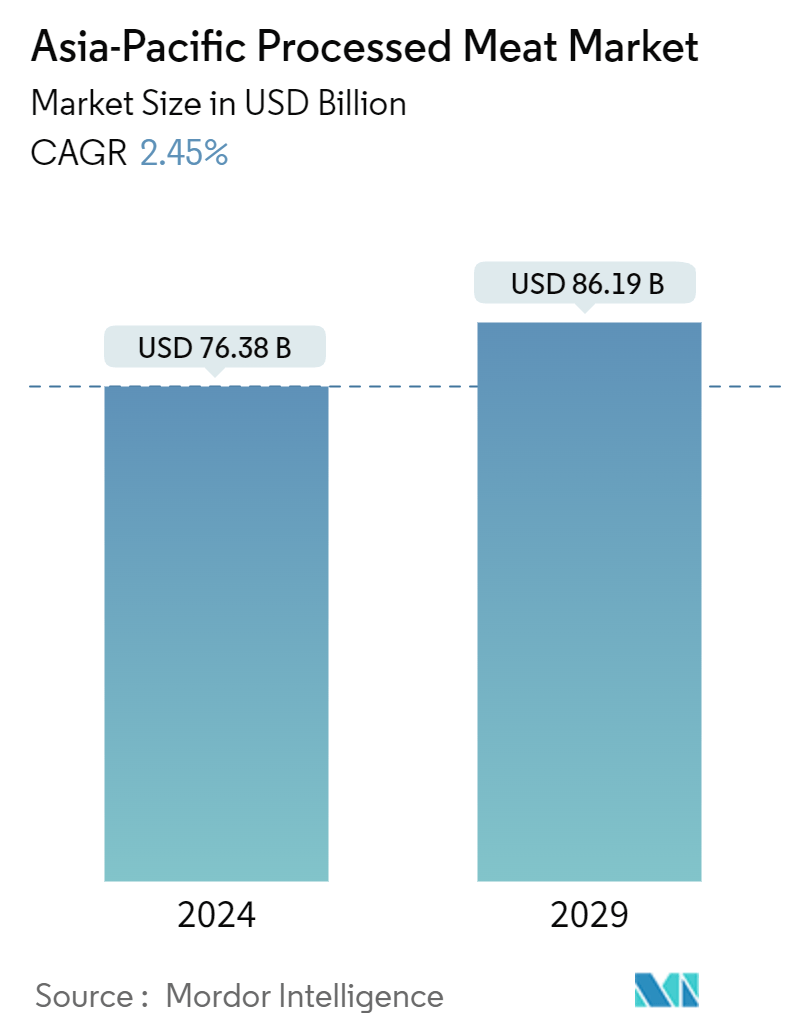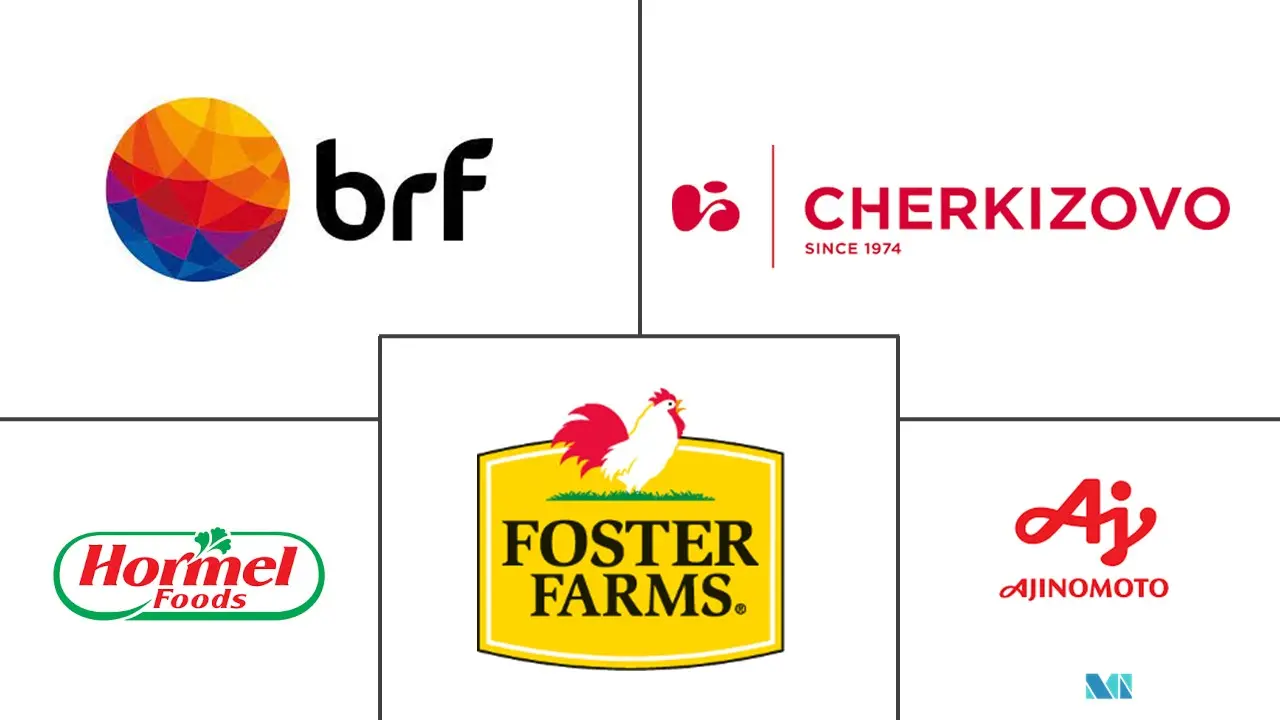Market Size of Asia-Pacific Processed Meat Industry

| Study Period | 2019 - 2029 |
| Base Year For Estimation | 2023 |
| Market Size (2024) | USD 76.38 Billion |
| Market Size (2029) | USD 86.19 Billion |
| CAGR (2024 - 2029) | 2.45 % |
| Market Concentration | Low |
Major Players
*Disclaimer: Major Players sorted in no particular order |
APAC Processed Meat Market Analysis
The Asia-Pacific Processed Meat Market size is estimated at USD 76.38 billion in 2024, and is expected to reach USD 86.19 billion by 2029, growing at a CAGR of 2.45% during the forecast period (2024-2029).
Increasing busy urban lifestyles in the Asia-Pacific region have resulted in consumers opting for tasty and healthy convenient foods that do not expend time for cooking or preparation. High meat consumption patterns in most of the countries in the region, like India and China, and rising preference for ready-to-eat meals are supporting the growth of the processed meat products market. For instance, according to OECD, in 2022, the consumption of poultry meat in India was found to be over four million metric tons, accounting for almost 4,253.74 thousand metric tons, which increased from 4,107.12 thousand metric tons in 2021. India is one of the leading producers of poultry meat in the world. The increase in the average income and the urban population has led to a tremendous increase in the demand for processed poultry meat products and a steady increase in consumption over the years. Additionally, the recent trend in India to establish large abattoirs-cum-meat processing plants with the latest technology is expected to further support the manufacturers to address the growing demand effectively. India has already established 10 state-of-art mechanized abattoirs-cum-meat processing plants in various states based on slaughtering buffaloes and sheep.
Moreover, with the world's largest population and a rising craving for meat, countries in the region like India and China are expected to be the biggest sources of increased demand. In addition, the young population in the region is consuming packed and processed meat products owing to their convenience and their sophisticated tastes. To address this growing demand and capture the market share, countries in the region are importing meat and then processing it with required preservatives. For instance, Chinese customs figures show that beef imports from the United States increased to 83,000 tons in the first eight months of 2021, nine times the volume in the same period a year prior, and were projected to reach more than USD 1 billion in 2022. The market is further being led by factors such as technological innovations pertaining to improved shelf lives of frozen meat products, packaging, and a rise in demand from the household and commercial sectors. Hence, the above factors are expected to boost the market's growth at a faster pace during the forecast period.
APAC Processed Meat Industry Segmentation
Processed meats are meat products preserved by smoking or salting, curing, or adding chemical preservatives. The Asia-Pacific Processed Meat Market is segmented by Type (Beef, Mutton, Pork, and Poultry), Product Type (Chilled, Frozen, and Canned/Preserved), Distribution Channel (Supermarket/Hypermarket, Convenience Stores, Online Stores, and Other Distribution Channels), and Country (India, China, Japan, Australia, and Rest of Asia-Pacific). The report offers market size and forecasts for the Asia-Pacific processed meat market in value (USD million) for all the above segments.
| By Type | |
| Beef | |
| Mutton | |
| Pork | |
| Poultry | |
| Other Types |
| By Product Type | |
| Chilled | |
| Frozen | |
| Canned/Preserved |
| By Distribution Channel | |
| Hypermarket/Supermarket | |
| Convenience Stores | |
| Online Stores | |
| Other Distribution Channels |
| By Country | |
| India | |
| China | |
| Japan | |
| Australia | |
| Rest of Asia-Pacific |
Asia-Pacific Processed Meat Market Size Summary
The Asia-Pacific processed meat market is experiencing significant growth, driven by changing consumer lifestyles and preferences for convenient, ready-to-eat food options. As urbanization increases and busy lifestyles become the norm, consumers in countries like India and China are increasingly opting for processed meat products that offer both taste and convenience. The region's high meat consumption patterns, particularly in poultry, are further bolstered by rising incomes and a growing urban population. This demand is supported by technological advancements in meat processing and packaging, which enhance the shelf life and appeal of these products. The establishment of modern abattoirs and meat processing plants in countries like India is also contributing to the market's expansion, enabling manufacturers to meet the growing demand effectively.
The market is characterized by a strong trend towards snacking, with consumers seeking high-protein, nutrient-rich options that fit their fast-paced lifestyles. This has led to a surge in popularity for processed meat snacks, particularly among the working population and younger consumers. Companies are responding by innovating and launching new products that cater to these preferences, such as clean-label ready-to-fry meat snacks. The market is highly competitive, with both regional and global players employing strategies like product launches, expansions, and mergers to strengthen their market presence. China, in particular, is a dominant player, with a focus on offering portable and indulgent meat products that cater to the snacking habits of its consumers.
Asia-Pacific Processed Meat Market Size - Table of Contents
-
1. MARKET DYNAMICS
-
1.1 Market Drivers
-
1.2 Market Restraints
-
1.3 Porter's Five Forces Analysis
-
1.3.1 Threat of New Entrants
-
1.3.2 Bargaining Power of Buyers/Consumers
-
1.3.3 Bargaining Power of Suppliers
-
1.3.4 Threat of Substitute Products
-
1.3.5 Intensity of Competitive Rivalry
-
-
-
2. MARKET SEGMENTATION
-
2.1 By Type
-
2.1.1 Beef
-
2.1.2 Mutton
-
2.1.3 Pork
-
2.1.4 Poultry
-
2.1.5 Other Types
-
-
2.2 By Product Type
-
2.2.1 Chilled
-
2.2.2 Frozen
-
2.2.3 Canned/Preserved
-
-
2.3 By Distribution Channel
-
2.3.1 Hypermarket/Supermarket
-
2.3.2 Convenience Stores
-
2.3.3 Online Stores
-
2.3.4 Other Distribution Channels
-
-
2.4 By Country
-
2.4.1 India
-
2.4.2 China
-
2.4.3 Japan
-
2.4.4 Australia
-
2.4.5 Rest of Asia-Pacific
-
-
Asia-Pacific Processed Meat Market Size FAQs
How big is the Asia-Pacific Processed Meat Market?
The Asia-Pacific Processed Meat Market size is expected to reach USD 76.38 billion in 2024 and grow at a CAGR of 2.45% to reach USD 86.19 billion by 2029.
What is the current Asia-Pacific Processed Meat Market size?
In 2024, the Asia-Pacific Processed Meat Market size is expected to reach USD 76.38 billion.

